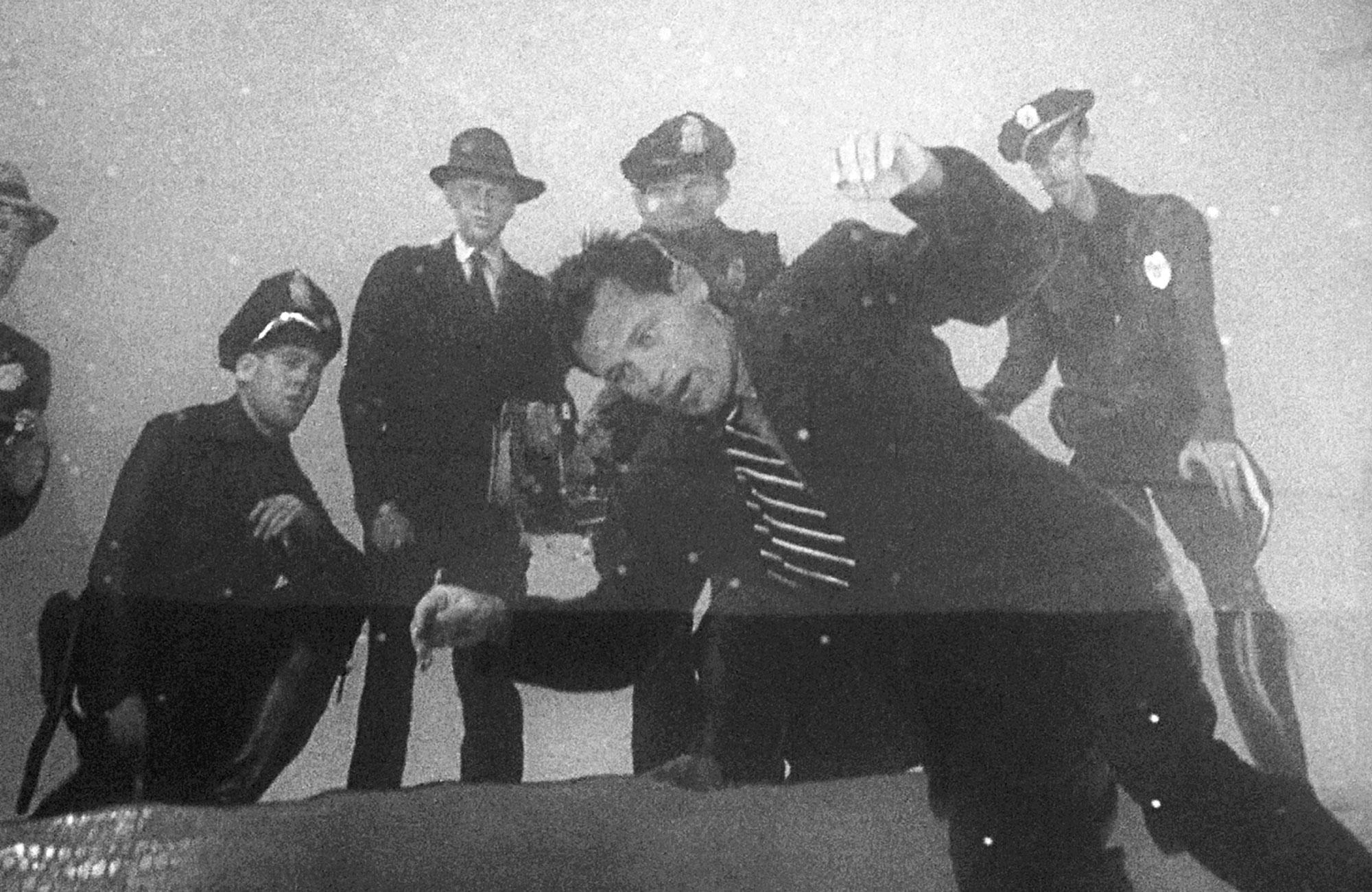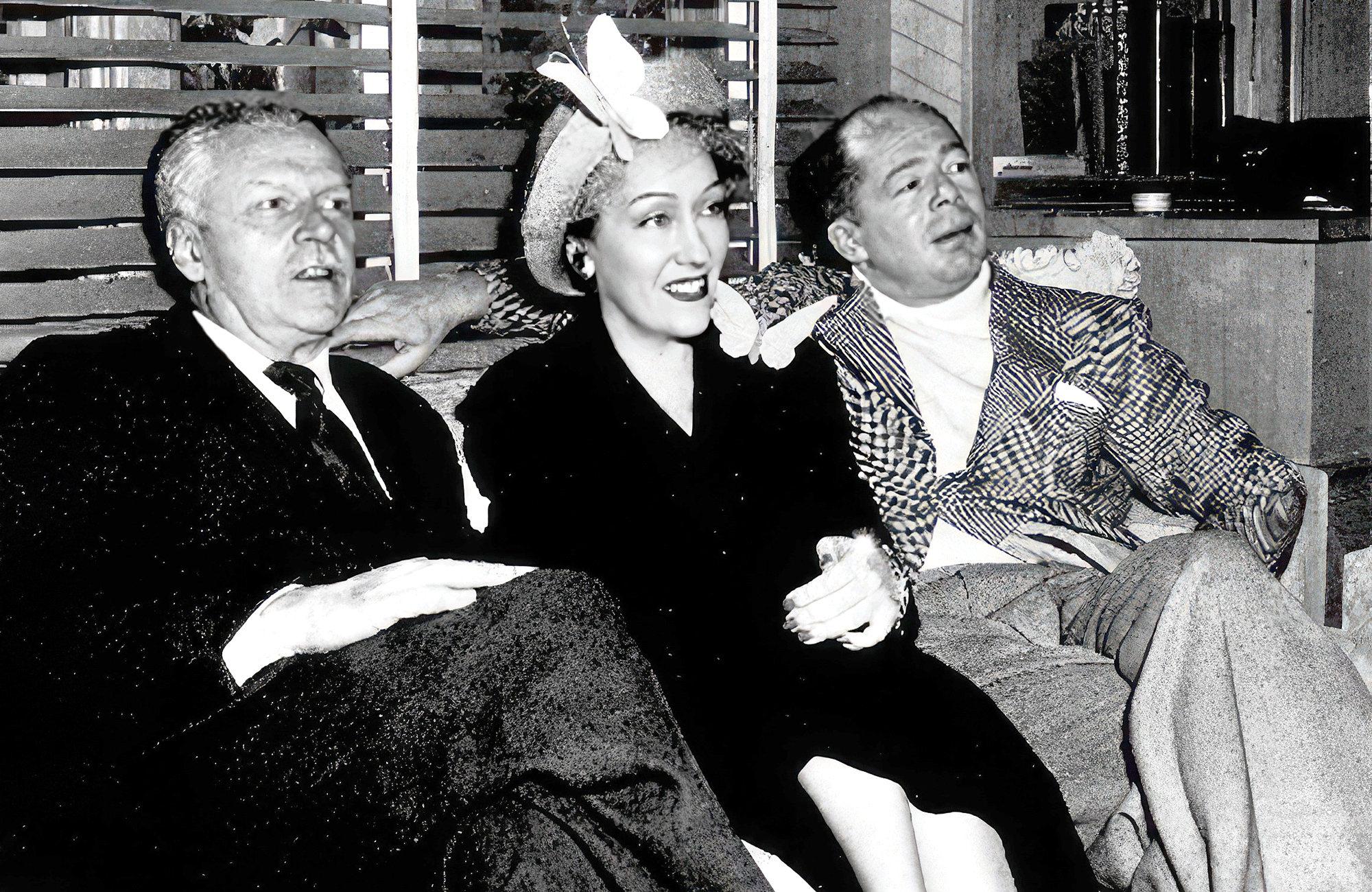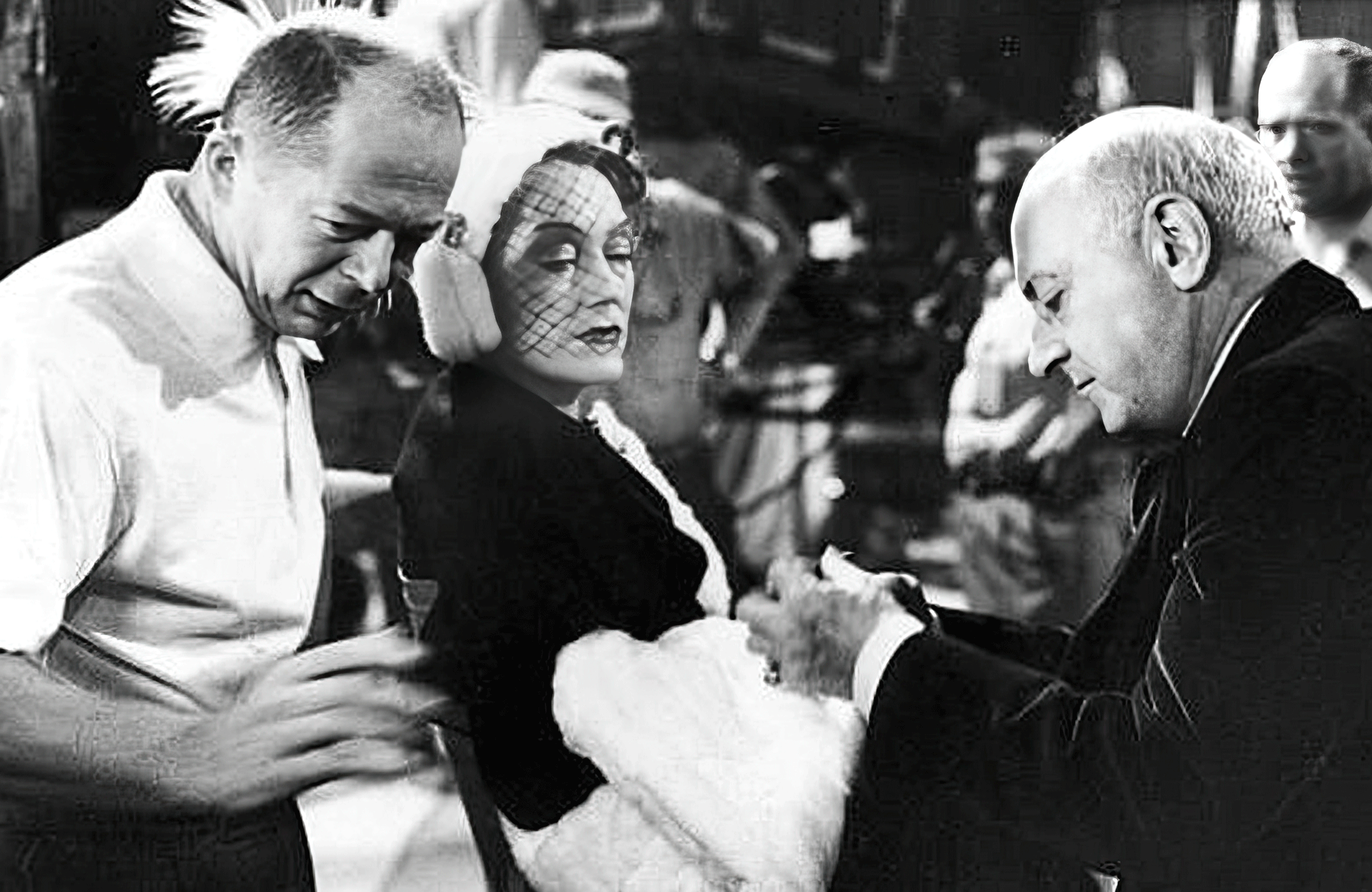“The question about a picture is not whether it’s good or bad, but whether it’s alive or dead.”
Billy Wilder, 1950
“The thing to do was suggest an idea, have it torn apart and despised, then a few days later it would turn up, slightly changed, as Wilder’s idea. Once I got adjusted to that way of working, our lives were much simpler.”
Charles Brackett, 1950
In some profound way, the surreal strangeness of Sunset Boulevard, the final film made by Billy Wilder and Charles Brackett at the end of their long and successful run as writing, producing, and directing partners during the golden age of Hollywood, was primarily focused on the subject and theme of life and death at the same time. Norma Desmond, the faded silent screen star played to perfection by actual silent screen star Gloria Swanson (with her actual former director Erich von Stroheim playing her butler and caregiver) is all about living in a state of suspended animation fueled by dreams of the past and the nightmare of a future without her former celebrity and acclaim. Few characterizations would ever more clearly embody novelist John Updike’s admonition that “Celebrity is a mask that eats into the face.” And few cinematic characters would ever embody the living dead noir sensibility quite as effectively as Swanson’s Norma.
In my book Double Solitaire, I explored the strange magic and personal dynamics behind the eventual creation of Sunset Boulevard, the corrosive culmination of the highly combustible and competitive partnership between Billy Wilder and Charles Brackett, as well as the huge impact of their many other classic films on our popular culture via an intimate glimpse behind the curtain of Hollywood’s golden age. By 1950, Brackett had collaborated with Wilder on thirteen films between 1936 and 1949, the year they made Sunset Boulevard together and won the Academy Awards for best screenplay and story, best art direction, and best music score. It was also the year that Charlie could no longer stand the constant conflict and bickering with his partner, the gifted but darkly disturbed Wilder, after which he made 39 more films without him.

Sunset Boulevard, with its arresting opening scene of a dead William Holden as Joe Gillis floating eerily in a swimming pool, was a pinnacle of the noir vibe. Seemingly shot from the bottom of the pool looking up, but ingeniously achieved by installing a large mirror on the bottom of the pool and shooting from above, I was struck by how much of a visual achievement this opening scene was, merging art with the narrative skills of a living novel. Ironically, Wilder and Brackett at first wanted to make a film adaptation of Evelyn Waugh’s 1948 novel The Loved One, about a failed screenwriter who lives with a silent film star and works in a cemetery, but they couldn’t obtain the rights. Tony Richardson would film it about fifteen years later.
One unexpected result was Sunset Boulevard, in which some of the satirical funereal skeleton of Waugh’s story can still be detected. Their resulting film often seemed more like philosophy or sociology accidentally assuming the shape of popular entertainment, and doing so in a comedic and tragic format simultaneously. And these two gifted storytelling partners did it all from within the confines of a claustrophobic and impossibly mismatched creative marriage, one that showed me that cinema really was a major part of the history of visual art and culture. The realization that films actually were paintings that moved, so to speak, has never entirely left me, and it has also drawn me into a love affair with movies that accepts the fact that they are a stolen series of photographic stills rapidly filtered past a shining lens in the darkness.
Brackett and Wilder’s fruitful but tumultuous collaboration was often rough going and presumably a long time both coming together and falling apart. Wilder confided to his biographer Charlotte Chandler that “a good writing collaboration is more difficult to achieve than a good marriage. And it’s more intimate.” So, when things crashed, they really crashed big time, with Matthew Dessem’s characterization from The Dissolve being a very apt one: “Over the years the two men worked together, they came to know each other better than anyone else ever would. And when the end came for Brackett and Wilder, it came with guilt and recrimination, jealousy and betrayal.” Perhaps the fact that Brackett knew him so well, maybe too well, was at least one of the reasons for Billy wanting his independence from his elder American writing mentor, the one who did, it’s best to recall, practically teach him English when he first emigrated to Hollywood from Austria via Paris.
Wilder further clarified his estimation of partnerships in general to Chandler like this: “It’s like pulling on the end of a rope. If you’re going to collaborate with yourself, you don’t need a collaborator. You need to have the rope stretched as tautly as you can get it. Out of the friction comes the spark and the sparkle.” Dessem’s take on their combination of foreign and combative forces together in tandem was also ideal: “In that sense, they were perfectly matched, because Brackett and Wilder may as well have grown up on different planets.” As if frozen in an artistic holding pattern by sheer sorcery, their partnership detente still somehow maintained its wildly argumentative stasis but also its astonishingly fruitful yield. There was always the next picture, and the next next one, each intersecting with the other in a way that brooked no easy withdrawal.
Most significantly, Brackett and Wilder were already talking about the germ of the movie that would be their final masterpiece together, after considerable mutations. “At the studio, Billy and I tried to evolve a new picture, and we discussed the idea for a comedy. It’s funny but a little piddling. Mae West and Jose Ferrer were considered for the parts.” After shifting from Mae West to Mary Pickford, then Norma Shearer, then Pola Negri, then Great Garbo, and finally to the great Gloria Swanson, and after also considering Marlon Brando and Montgomery Clift for the role of Gillis, they settled on the seemingly effortless everyman excellence of Bill Holden. Thank the Goddess none of those earlier renditions came to pass. What we have actually ended up with being perfection.
While tweaking the skeleton drafts of what would eventually morph into Sunset Boulevard, Wilder had commented, “You know, we will have more violent political disagreements on this picture than we have ever had.” To which Brackett responded to his private diary, “Suddenly I thought, ‘Oh no we won’t, because I can’t go through the disagreeableness of association with you any longer. After all, an Oscar one night a year is agreeable. But is it worth looking at that face and listening to that ego all the other days in the calendar? …. and the answer was, No.’” Still the work continued, with Billy appearing to admonish Brackett: “This is the last picture we will do together. I want to do things more politically daring than you would permit. I want to stop working, to start when I want to. I am no longer afraid.” Brackett noted that he heard this with a mixture of consternation and relief, “for the stress of working on this picture has been hellish. Still, we resumed writing.” Some strange alchemy just seemed to be at work inside both of these two unaligned collaborators.

As their production deadline approached, the partners scrapped several back burner ideas they had on simmer and decided to focus exclusively on the Hollywood story. “Billy came across with the wildest, most arresting frame for our picture. Our hero is brought dead into the morgue and tells the other dead occupants of the morgue the events leading up to his death.” After being temporarily elated with his manic ideas, Wilder returns to his usual state of mind the next day. Also as usual, the only person in which Brackett could confide was his own diary. “Billy in one of his preposterous moods, a mood of resentment and suffering, brooding angrily most of the time, and all of the time a list of the faults of America. A dull lonely day at the studio, its only happiness the negative one of not having to see and be in the room with and feel myself absorbed in the life of Wilder.”
Further observations in his diary often focused on the frequency of what Brackett called “stalled and agonized days.” Yet the long, long year 1949 would finally end, feeling as if there were several years of emotional and creative struggle packed into one single slot on the calendar, and with it, so did Brackett’s journaling habit of chronicling the secret life of Billy Wilder.
Sunset Boulevard, perhaps the penultimate movie about movies, was released August 10, 1950, by Paramount Pictures. Directed by Billy Wilder; produced by Charles Brackett; screenplay by Charles Brackett, Billy Wilder and DM Marshman; cinematography by John Seitz; edited by Doane Harrison and Arthur Schmidt; music by Franz Waxman; and featuring Gloria Swanson, William Holden, Erich von Stroheim, Nancy Olsen, Fred Clark, Lloyd Gough, Jack Webb (with Buster Keaton, Hedda Hopper, Sidney Skolsky, Anna Nilsson, HB Warner, Henry Wilcoxon, and Cecil B. DeMille).
Ninety-eight percent of critics gave the film a positive review, and The Hollywood Reporter wrote that “future generations will set themselves the task of analyzing the durability and greatness of the film.” Which is, indeed, precisely what we have done.
When he was interviewed by Philip Scheuer for The Los Angeles Times in August of 1950, it was clear that one of Wilder’s new mandates, in addition to reinventing himself from the ground up, was also reinventing the story of his ascent. Thus began the building of his own personal Wilder mythology, the one in which his genius was so innate that he never really needed anyone’s support or creative scaffolding. In fact, when he sat down to talk with Scheuer for his suggestively titled profile titled “Wilder Seeks Films with Bite,” he was in a far ranging and expansive mood with an appetite for clarifying everything that had come before that very moment. How exactly he might surpass the ‘bite’ contained in the two Oscar-winning noir classics he had made with Brackett he never did quite specify.
Scheuer cannily observed: “Wilder, who is likely to have his wish now that Sunset Boulevard, which he co-wrote and directed, is in general circulation, thinks of himself as a writer who is lucky enough to be able to follow through on his own yarns.” Chief among those yarns may have been the myth that he was solely responsible for every inch of his success, a yarn that would gain momentum and scale with each passing year of his independence. But of course, that lucky writer also had two new collaborators, and a new associate producer to assist him in doing everything by himself, eventually the great I.A.L. “Izzy” Diamond. As Scheuer observed, “Long associated with Charles Brackett, he and Brackett separated, he said, ‘because the studio wanted to get two pictures a year out of us instead of one. So we split up. He gets another director and I get other writers to work with, but I sure miss him.’”
Oh, the joys of hindsight. “I always make things very tough for myself, by not going out and buying a successful stage play or novel but starting, instead, from scratch. The wonder is that Sunset Boulevard ever got made at all for that reason alone: usually a studio prefers to bank on a sure-fire property.” But somehow Sunset Boulevard did miraculously in fact get made, even though it had both sharp satirical bite and dark humor aplenty, and one of the chief reasons was the longtime collaborator Wilder had just dispensed with. Richard Gehman has commented that Wilder’s successful attempt to take Hollywood by storm was fraught with challenges from the beginning, chief among them learning English. “Wilder and Brackett became legends.” As Gehman put it in a Playboy profile, “They were known for the ability to work anywhere—in barber chairs, while playing cribbage, or at parties. Eventually they were regarded as a pair who could do no wrong. Then they made Sunset Boulevard, one of their best, in 1950, at the peak of their partnership, and yet they split up. Neither will say exactly why.” Actually, both have said exactly why, many times, although those reasons vary depending on who tells the story.

In the case of the formerly ‘happiest couple in Hollywood,’ both partners had to make sacrifices, of course; it’s just that one had to make more of them, more often. Whether Wilder ever actually realized how difficult he was to work with, even to be with, is debatable. Manic depressives are not that well known for their startling insights of self-discovery, but he did recognize the Yiddish concept of beshert, something inevitable or preordained, as being active in the apparently random decision to pair him with Brackett. “I thought it was a fine idea,” he told Burt Prelutsky for Michigan Quarterly Review much later in his life, admitting, “I already had great respect for Brackett. He was much older than I was and had written several good novels and many fine pieces for The Saturday Evening Post. I had no confidence when I was first starting out because I only knew English from going to the movies. After Brackett and I split up, I found it too lonely to write by myself. I find I miss having a collaborator, a sounding-board, someone whose taste and ideas I respect. Also, having a collaborator makes you come in to work on time.”
For Matthew Dessem of The Dissolve, the creative divorce appeared to be a necessity, at least from Wilder’s perspective, “He did what he had to do, to move forward. It’s true that he wasn’t polite about it. But even if Wilder had all of Brackett’s finely taught courtesies, nothing could have masked the fact that they were no longer equals. It’s unforgiveable to cause pain for art’s sake. But in this case, the pain was a given. Brackett and Wilder’s final days of writing together show that both men understood art’s power to transmute that pain into something immortal.” There it is again, the immortality incentive that was always being dangled in front of creative artists, especially those toiling in the dream factory of Hollywood, one of the few places on earth where such immortality might even be a possibility, if the necessary sacrifices are correctly made.
So, it was all the more poignant, not to mention startling, after their masterpiece was finished but prior to its official premiere, that Brackett met with Wilder in their office, as Brackett recounted here: “Billy smiled that sweet smile of his at me and said, ‘You know, Charlie, after this, I don’t think we should work together anymore. I think it would be better for both of us if we just split up.’” This left Brackett without a single appropriate word in response. Up until that point, Brackett had chosen to endure the sturm and drang that emerged between them mostly because apparently Wilder had pledged to him that this film would be a tenderly touching story about a faded and possibly nutty silent film star who decides to make a comeback.
It was supposed to be, in Brackett’s hopeful mind, something of a high-minded comedy, and Brackett still harbored a personal fondness for the light comedy of manners mode. But Wilder, whose post-war European sensibility had perhaps come to embrace a high degree of unalloyed cynicism and pessimism, shifted the emphasis, slowly at first and then rapidly, to a more dour and distressing state of almost complete reality-collapse. This slow-motion cave-in of the famous actress’ self-image was accompanied by a lot of the attitudes and behaviors that might envelop a loopy narcissist, and it was many of these elements that disturbed and eventually angered Brackett. Some of them, such as the sequence of Swanson as Desmond submitting to a rigorous regime of beauty treatments to restore her luster, he found offensively vulgar. William Schorr had become Brackett’s Associate for this project, and he recalled a screening of early scene rushes when the two partners actually came to blows over scenes that Brackett, as producer, wanted cut, and Wilder, as director, wanted left in. Schorr sided with Wilder, and Brackett stormed out of the screening room. That was the point at which Brackett may have washed his hands, psychologically at least, of attempting to navigate their precarious partnership any longer.
The Rubicon had finally been reached and crossed, and as Dessem summed it up rather succinctly: “On March 29, 1951, the accolades for Sunset Boulevard became official. Brackett and Wilder’s career ended with another Academy Award, shared with DM Marshman, for Best Writing, Best Story and Best Screenplay. Wilder and Marshman entered from one side of the stage, Brackett entered from the opposite side (as Academy President, he may have already been backstage) and thus Brackett and Wilder were finished.” It should be noted that just as they had entered that ceremony from different sides of the stage, and as if further memorializing their memorable partnership in an apt final metaphor, so too did they leave the stage, in opposite directions.
Donald Brackett is a film critic/curator and author based in Vancouver, Canada. In addition to writing numerous articles for Critics At Large, Offscreen, Xibit, Arcade Projects, Found Footage, and Embodied Meanings, he is the author of the recent books Yoko Ono: An Artful Life (2022), which focuses on the conceptual artist’s experimental films; and Double Solitaire: The Films of Charles Brackett and Billy Wilder (2024), examining their unique creative partnership. He has curated programs for Cinematheque, among them Strange Magic: The Films of Charles Brackett and Billy Wilder (2013). He is currently curating a follow-up program of Wilder’s independent films with I.A.L. Diamond, Go Your Own Way, as well as working on a new book about Billy Wilder’s contributions to independent cinema.

© 2025 Heart of Noir